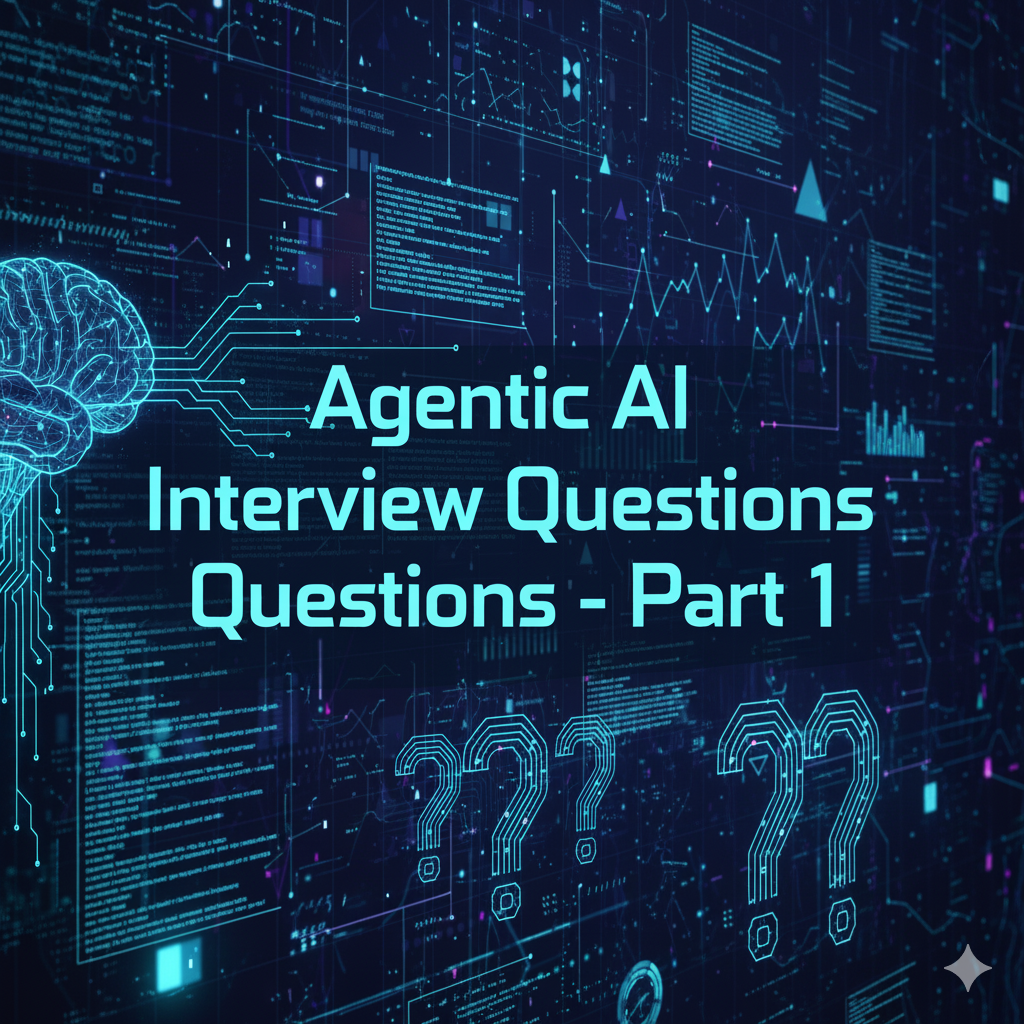Welcome to Part 1 of our Agentic AI Interview Questions Series, your go-to guide for mastering the emerging field of agentic AI. With the rise of autonomous systems and intelligent agents that can reason, plan, and act independently, agentic AI is becoming a crucial topic in interviews for roles in cutting-edge AI research, product design and multi-agent systems engineering.

Whether you’re applying to AI labs or startups innovating in autonomous agents, this guide breaks down 15 essential agentic AI interview questions with detailed answers to help you stand out.
1. What is Agentic AI?
Agentic AI refers to artificial intelligence systems that possess autonomy, goal-directed behavior and the ability to make decisions in dynamic environments. Unlike traditional AI models that passively respond to inputs, agentic systems proactively initiate actions, collaborate, reason and adapt over time.
Agentic AI often incorporates elements such as:
- Planning (e.g., task decomposition)
- Memory (for temporal continuity)
- Tool use (API calls, retrieval systems)
- Reflection (updating future strategies based on past outcomes)
This paradigm powers next-gen systems like AI copilots, decision-making assistants, multi-agent coordination tools, and autonomous software agents.
2. How is Agentic AI different from standard LLMs?
While standard LLMs like GPT-4 respond to inputs in a single pass (stateless and reactive), agentic AI systems are:
- Stateful: They retain memory across steps.
- Goal-driven: Agents operate with objectives and subgoals.
- Interactive: They can plan sequences of actions and adapt based on feedback.
An agent might leverage an LLM as a reasoning engine, but it wraps around it a planner, executor, tool interfaces and often feedback loops allowing the system to operate autonomously over time or across tasks.
3. What are the core components of an agentic AI system?
Typical components include:
- Planner: Decomposes goals into actionable steps.
- Memory: Stores contextual or episodic information.
- Tool use / APIs: External system access (e.g., databases, web search).
- LLM Reasoner: For flexible natural language reasoning.
- Controller / Orchestrator: Manages task execution flow.
- Feedback mechanism: Reflects on outputs, errors, or environment signals to revise actions.
These components work together to simulate human-like autonomy and adaptability in open-ended tasks.
4. What is task decomposition and why is it important in Agentic AI?
Task decomposition refers to breaking down a complex goal into simpler, manageable sub-tasks. It’s essential in agentic systems to:
- Enable long-term planning
- Improve reasoning transparency
- Allow parallel execution or delegation
For instance, a travel booking agent might break “Plan a trip to Paris” into: (1) Search flights, (2) Find hotels, (3) Build itinerary.
5. What role does memory play in agentic systems?
Memory allows agents to:
- Track previous decisions or conversations
- Maintain context over time
- Reflect on and improve behaviors
Types of memory:
- Short-term / scratchpad memory: Holds recent context in a session
- Long-term memory: Stores knowledge or persistent user info
- Episodic memory: Records past experiences or tasks
Memory is key for building persistent, context-aware agents that operate across sessions.
6. Explain tool-use in the context of agentic AI.
Agents often augment their capabilities using tools such as:
- Search engines
- APIs (e.g., weather, finance, calendar)
- Databases (e.g., vector stores)
- External scripts or models (e.g., for math or code)
The tool-use loop involves:
- Detecting a subtask requiring external input
- Invoking the tool
- Interpreting the result
- Resuming the plan
Tool-use transforms agents from pure text generators to autonomous executors.
7. What is ReAct prompting?
ReAct (Reason + Act) is a prompting strategy enabling agents to:
- Reason step-by-step (chain-of-thought)
- Act via tool use or environment interaction
- Reflect, and repeat
Example prompt:
Thought: I need the current weather to recommend attire.
Action: Search[weather in New York]
Observation: It's 5°C and snowing.
ReAct improves interpretability and aligns LLM outputs with agent workflows.
8. What are agent loops?
An agent loop is the iterative decision-making cycle that agents follow:
- Observe the environment or task state
- Decide the next action (reasoning)
- Execute an action (via tool or LLM)
- Observe outcome and update memory
- Repeat until goal is achieved or timeout
This loop enables autonomy and adaptability, allowing agents to learn from interaction.
9. What is multi-agent collaboration in AI?
Multi-agent systems (MAS) involve multiple agents working together toward shared or individual goals. Collaboration requires:
- Communication protocols (e.g., messages, shared memory)
- Role specialization (e.g., planner vs executor agents)
- Coordination (e.g., through central or decentralized control)
Applications include game-playing bots, swarm robotics and agent-based simulations.
10. How does LangGraph facilitate agentic workflows?
LangGraph is a framework that models agents as state machines, enabling:
- Cyclical control flow
- State transitions
- Parallel branches (e.g., multi-agent planning)
- Error handling and memory updates
LangGraph simplifies building multi-step, resilient and asynchronous agentic systems.
11. What are common challenges in building agentic AI?
Key challenges include:
- Hallucination during reasoning or tool-use
- Looping or stuck agents
- Latency due to long tool-chains
- State management and debugging
- Evaluation of open-ended behavior
Solutions involve rigorous prompt engineering, fallback strategies, better memory control and simulation testing.
12. How do you evaluate agentic systems?
Unlike static LLM tasks, agent evaluation is dynamic. Metrics include:
- Task success rate
- Tool usage accuracy
- Efficiency (steps to goal)
- Error recovery capability
- User feedback or satisfaction
Evaluation often requires custom simulators or human-in-the-loop setups.
13. What is AutoGPT and how is it different from standard agents?
AutoGPT is an early example of autonomous agents that:
- Accept a user-defined goal
- Plan steps with LLMs
- Execute actions via tools
- Iterate through goals until completion
It’s essentially a self-prompting, looping system. However, early versions had issues with coherence, looping, and memory highlighting the importance of structured agent design.
14. What is a reflection mechanism in agentic AI?
Reflection allows agents to evaluate past actions and improve future behavior.
For example, after task failure:
- Agent logs the error
- Updates memory with insights
- Adjusts plan (e.g., retries with a different tool)
Reflection is a form of self-supervised learning that improves long-term performance.
15. Where is Agentic AI used in the real world today?
Examples include:
- AI coding agents: Dev tools like Devin or SWE-agent
- Customer support bots: Autonomous ticket handling
- Research agents: Arxiv summarizers or literature mappers
- Personal assistants: Calendar planning, search + summarize
- Game agents: Multi-agent behaviors in strategy games
Agentic AI is shaping the future of autonomous software, enabling systems that think, act and learn like dynamic collaborators.
Conclusion
This first part of our Agentic AI Interview Series has introduced you to the foundations of agent-based systems from task decomposition and memory to tool use and multi-agent collaboration. As autonomous agents evolve, mastering these concepts will be essential for next-gen AI roles.
Stay tuned for Part 2 where we’ll cover:
- Auto-reflection agents
- Planning with external knowledge bases
- Hierarchical agent architectures
- Evaluation techniques
- Safety and alignment in autonomous agents
Related Read
Deep Learning Interview Questions – Part 5

2 thoughts on “Agentic AI Interview Questions – Part 1”